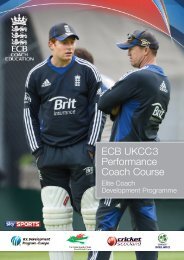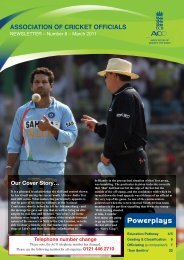ECB ACO Newsletter - Spring 2013
ECB ACO Newsletter - Spring 2013
ECB ACO Newsletter - Spring 2013
You also want an ePaper? Increase the reach of your titles
YUMPU automatically turns print PDFs into web optimized ePapers that Google loves.
Beyond the Boundarycontinued from page 3all fascinated by the topic, regardless ofthe fact that 95% of our members willnever raise their arms to draw that imaginaryrectangle in the sky!So, why don’t we start with the obviouspair of incidents… was Jonny Bairstowout? No, but yes, because India would notwithdraw their appeal. Lots of querieshere even though DRS could not influencethe outcome – which is the strangest pointbecause without the ability for either sideto have an official ‘DRS’ review of the incident,Andy Flower had had to solicit theassistance of the broadcast videos to clarifythe detail of the catch, so it is hardly asurprise that after this, MS Dhoni declinedto accede to the ‘unofficial DRS’ evidence,even though on the last two similar occasions,they have sympathised and acceded.So, next, was Alastair Cook out? Yes. Hewas out of his ground and the fielder(Kohli) threw down the wicket. The mutteringswere to do with ‘self-protection’and ‘avoiding-injury’ obviously, andmaybe appropriately – but without the officialDRS, who was to judge whether theball was indeed either close enough forhim to need to hold back or whether hehad either seen it or presumed its directionof flight, or did not and it was never goingto hit him anyway? On top of this therewas the short video re-run of the umpiresconsulting – may have to ask with respectto the Laws, would any question havebeen relevant?Thus it is that one country, the host nationin this instance, has declined the useof DRS, and the visiting country, Englandin this instance, lost two wickets on appeal– one of which would have been reversedand one that still might not havebeen made any the clearer. And it is onthis last point that India – and others - hasa grip of reality on the debate. It is no usehaving a system using technology if thetechnology is not 100% accurate. And itshould be. Which opens up yet more debateon the contrasting or competing meritsof HawkEye vs VirtualEye… fuelledby Jacques Kallis’ questioning of theball-tracking data.Yet another typical incident – and anothernail in the not-up-to-it techno view –was an appealed-for stumping in the lastODI between South Africa and NewZealand; the batsman’s toe appeared to beon and behind the line from the cameraangle at square-leg but not over the linefrom the camera at point; 2 identical cameraslooking at exactly the same image –and the foot was either ok or not and notboth. And if we would all agree that theTV official could look at both cameraviews and accept one and not the other,how does he know 100% which of themwas truly accurate, and how, with such achoice, can he be 100% neutral? Youmight be tempted to suggest that the benefitof the doubt should – as the Laws state– be given to the batsman, which would beironic as we all do this adequately enoughevery week and without technology?It is a salutary reminder to each of us todevelop that level of personal certainty –the inner confidence to believe in our first,fast, initial judgement, to stay with it, andthen watch it become demonstrably accuratein the video re-run. And we can dothis very comfortably at home duringthese winter months with a whisky-mac inhand watching cricket from the tropics!A ‘Work in Progress’ is what theglobal cricketing fraternity should admitDRS is, but still use it as often as possibleand ‘down-the-ladder’ as far as feasibletoo. So we have an even more challengingseason ahead. And add to this thecap-cameras that the ‘BigBash’ T20 umpiresare wearing and the illuminatingbails and stumps! What else can we expectin <strong>2013</strong>?PjTDRSAlastair Cook watching the ball beforeavoiding being struck and in turn being runout after not making his groundFlashing stumps in the Big BashUmpire’s camera visible during theinfamous Warne and Samuels ‘bust up’‘You are the umpire’Sports illustrator Paul Trevillion teams up with ex-professional cricketer and Test umpire John Holder to compile a funand informative guide to the laws of cricket. Based on a Q&A style it is accompanied by official answers andanecdotes from John’s 35 years in top class cricket.42. Graeme SwannJohn Holder’s verdict1) Neither. You can only ever give a batsmanout if you are certain about the method ofdismissal. In this case there’s little or nocertainty – he cannot be out caught if the balldidn’t clip the bat – and so your decision hasto be “not out”. This is one of the challengesof umpiring: you need to take your time,think through the sequence of events and say“Not out” firmly and confidently – even ifthere are butterflies in your stomach becauseof the uncertainty. Ben Collier wins the book.2) The law was changed in October 2010:now the umpires alone decide on the fitnessof the ground for play. Captains are notconsulted, nor are they allowed toaccompany you on inspections. It meansumpires can now avoid the sort of rows thatused to blow up when captains had a say –such as the one in my first year as a first-classumpire in 1983, when the Middlesex captainMike Gatting was desperate to resume, andhis opposite number for Somerset, IanBotham, was determined not to...With Middlesex fielding in Somerset’se-mail us at ecbaco@ecb.co.uk 4 contact us on 0121 446 2710












![Indoor Sports Halls with Cricket Provision [TS3] - Ecb - England and ...](https://img.yumpu.com/49070696/1/190x135/indoor-sports-halls-with-cricket-provision-ts3-ecb-england-and-.jpg?quality=85)



